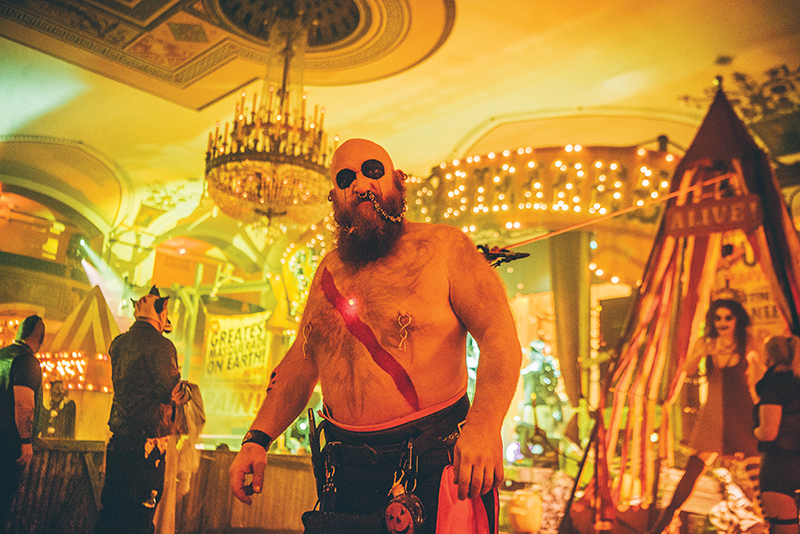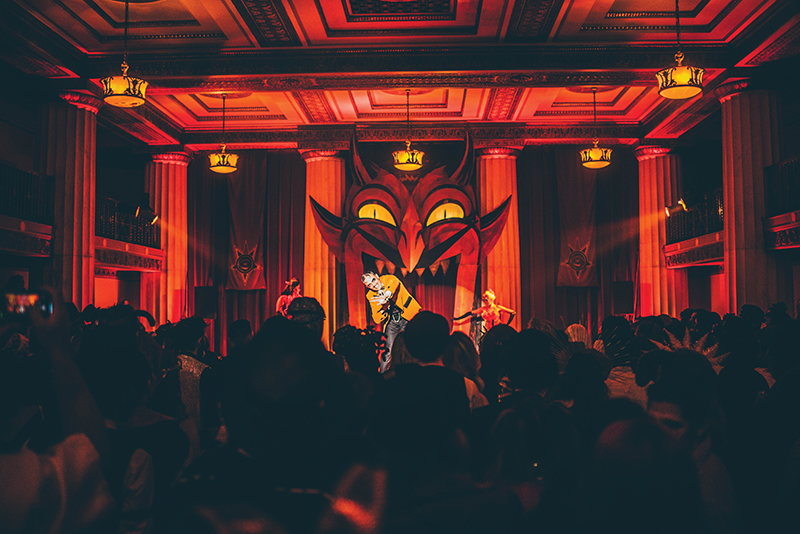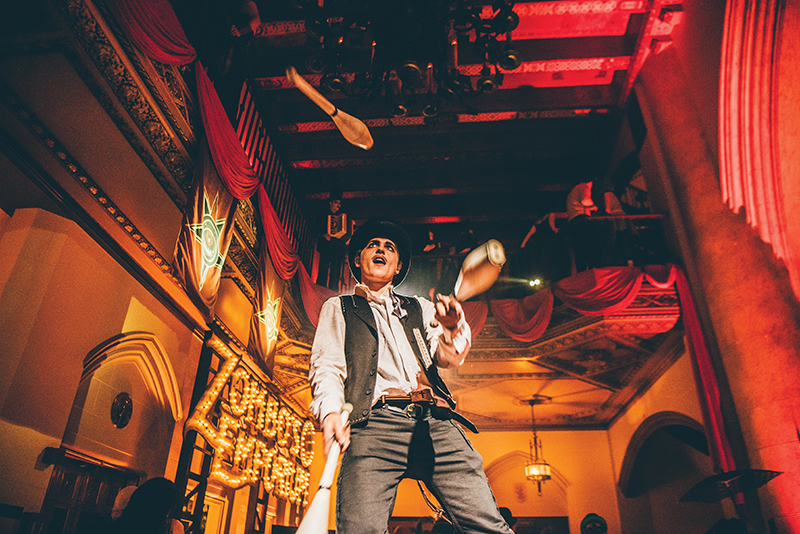
Around this time last year, costumed Detroiters could be found promenading through elaborate, crimson-lit carnival sets, ogling grotesquely clad contortionists and glamorous burlesque dancers, and professing devotion to an impishly ominous deity named Zombo. But alas, the party is off this year. A pandemic-induced hiatus — not the first obstacle in its colorful, 20-year history — will leave loyal patrons of the annual Halloween bacchanalia known as Theatre Bizarre replaying wistful memories from previous years and hoping for a grand return in 2021.
Though hardly the eight-floor extravaganza it would later become, the notoriously wild party got its start in 2000, occupying just six plots of empty land in a blighted northeast Detroit neighborhood. At the time, Theatre Bizarre was no more than a passion project, put together by a group of friends who had no intention of profiting from it. Even the first year’s dark-circus theme was meant to be a one-off. But the event was an instant hit, and co-founder and creative director John Dunivant became enamored with its artistic potential.
Though Theatre Bizarre was a collective endeavor, Dunivant — along with Ken Poirier, who owned the lots comprising the “fairgrounds” — was chief ringleader. While Poirier managed most of the party’s logistics, Dunivant was the creative force. “Throwing huge parties was never my intention,” he says now. “But I loved the idea of building a world — especially because I was building it with friends and family.”

Over the next 10 years, Theatre Bizarre’s six plots expanded to 23, and the number of patrons rose rapidly from the 600 who attended in 2000. By 2010, the event was drawing people from as far away as Spain, Germany, and Dubai — a massive feat for pre-comeback Detroit.
That year saw Theatre Bizarre’s biggest expansion to date, with additional stages, a Ferris wheel, a homemade rollercoaster, and a freshly built Frontierland. But the drug wars that had plagued the neighborhood and had for years kept the event from drawing the attention of otherwise-occupied police were starting to let up, and the powers that were began to take notice.
The night before that year’s party, organizers received a visit from police Chief Ralph Godbee Jr., the health department, the fire marshal, and even, as Dunivant recalls, a couple SWAT teams. With no permits and a list of code violations so long it would land them in court for a year, they were shut down. “We had 18 hours until doors, and we’d spent a quarter of a million dollars that there was no way we’d be able to pay back to the ticket holders,” Dunivant recalls.

So they scrambled to find a new venue. They called in every favor they could and finally got an 11 p.m. meeting with the board at the Fillmore, whose members, Dunivant later learned, were planning to tell them no. “Originally, they were just hearing us out as a favor to a friend,” he says. “But I think they saw how desperate we were.”
After arranging a convoy of trucks to the new venue and spending all night pulling everything they could from Theatre Bizarre’s fairgrounds, the team was able to salvage the event. Still, it was the end of an era, and everyone involved knew the Fillmore wasn’t meant to be Theatre Bizarre’s permanent home.
Despite attempts to find new stomping grounds in various warehouses and abandoned buildings, Dunivant says, nothing felt right — until they toured Detroit’s Masonic Temple. Equal parts mysterious, majestic, and macabre, the 94-year-old building perfectly suited Dunivant’s artistry, which was already evolving to incorporate secret-society iconography reminiscent of the Freemasons.

Still, molding a permanent display originally built for the open air into a modular set that could fit through antiquated doors and hallways and be disassembled yearly was no easy task. Patrons took notice, Dunivant says, and the event lost a slew of diehard fans in the first few years. This was also around the time Poirier left Theatre Bizarre.
But most of the team was determined to rebuild the striking phenomenon they’d created over the previous decade. “Our choices were start over or die. And none of us wanted it to die. We were doing something that was really connecting with people, so we did everything we could to pull it off.”
In doing so, Dunivant embraced the Masonic Temple’s vibe by adding layers to the Theatre Bizarre narrative and giving additional play to the event’s emerging mascot, Zombo the clown. Inspired by lore behind the Masonic Temple, the event became one large ritual meant to open a portal to a carnival of the past and summon Zombo, the godlike ringmaster at its center.

Now taking over 300,000 square feet of the Masonic Temple for four nights each October and typically hosting nearly 9,000 visitors, Theatre Bizarre is truly more than a party. With multiple bars, carnival games, vintage horror and erotic film screenings, a creamery that serves custom, boozy ice cream varieties, plus bondage and suspension demonstrations, a wild train ride, and performances by acrobats, fire performers, burlesque dancers, bands, and Theatre Bizarre’s own orchestra, it truly is an experience. Which is exactly how Dunivant wants patrons to think of it. “This world is a labyrinth designed to be explored and interacted with,” he says.
While guests are free simply to enjoy the party, they’re encouraged to dive into the narrative. With hidden rooms, speakeasies, and new things to discover around every corner, Theatre Bizarre is designed to reward the curious. “If you explore deeper, you might get pulled into a ritual that could scare or excite you in some way,” Dunivant says. “There are a lot of things that could cause offense or discomfort. This event is meant to push boundaries.”
But by early this spring, the writing was on the wall for Theatre Bizarre 2020, and in May, Dunivant made the decision to pull the plug. Having already lost two loved ones to the pandemic, Dunivant wasn’t willing to take chances.

On top of the obvious risks for patrons, he says, much of the Theatre Bizarre team moves into the Masonic Temple during its busiest building time. “At this point, there would be members of my crew who die,” he says. “And I’m not going to have that happen.”
But Theatre Bizarre is nothing if not durable, and Dunivant already has some things in mind for its return. For instance, 2020 would have marked the event’s 20th anniversary, and Dunivant intends to have his celebration. Even if it’s not precisely 20 years from its start, the next Theatre Bizarre will be the event’s 20th iteration.
Such a return, Dunivant says, reminds him of 2007, when, after taking two years off from opening up the party to the public, Theatre Bizarre came back with a rising-from-the-dead theme — an idea he might want to revisit. For an event with a history so marked by death and rebirth, it’s hard to think of a more fitting theme.
|
| Ěý |
|








